What are the biggest threats in 2016?

From migration to governance failure ... these are the risks to global security
Image: REUTERS/Luke MacGregor
Stay up to date:
Migration
From the refugee crisis to terrorist attacks and cyber security to climate change, global risks dominated last year’s headlines. The World Economic Forum’s Global Risks Report 2016 analyses the impact and likelihood of global risks for the coming year, and over a 10-year period. So what are the biggest threats to the world in 2016, and which are most likely to happen?
This year’s assessment finds the biggest risk in terms of potential damage is a failure to mitigate and adapt to climate change. It is likely to have a bigger impact than the spread of weapons of mass destruction, water crises, large-scale involuntary migration and a severe energy price shock, the report found. This is the first time since the report was launched in 2006 that an environmental concern has topped the list.
The risk most likely to materialize in 2016, meanwhile, is large-scale involuntary migration, followed by extreme weather events, failure of climate change mitigation and adaptation, interstate conflict with regional consequences and major natural catastrophes. Europe is already experiencing unprecedented levels of refugee flows, and the pressures driving people from their homelands are unlikely to abate in the coming year.
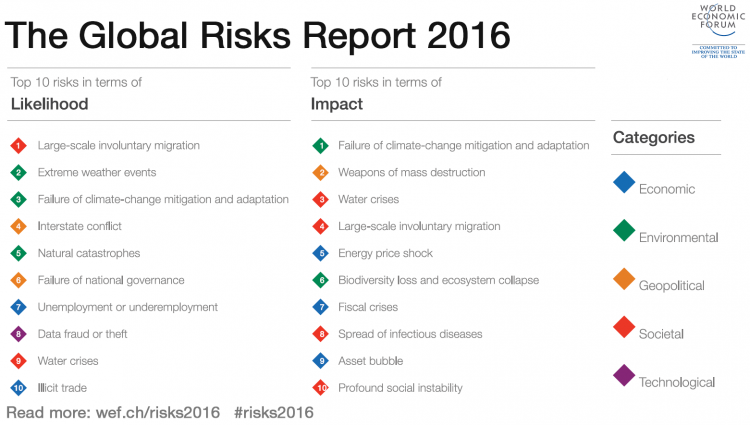
What should we be most concerned about?
Experts surveyed for the report also name the risks they are most concerned about over two time frames: 18 months and 10 years.
The report says global risks that have received widespread media coverage recently such as large-scale involuntary migration and interstate conflict tend to be ranked higher as short-term concerns, while risks related to geographical and societal trends, such as failure of climate change mitigation and adaptation and water and food crises, are more likely to be considered long-term threats.
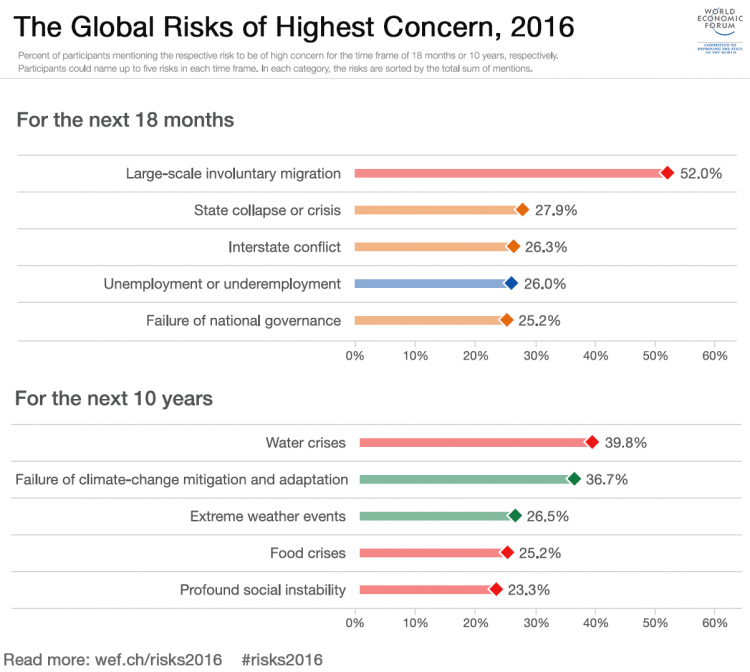
These are the top five highest concerns in the next 18 months, as nominated by the group of experts:
1. Mass involuntary migration
As well as being the number one risk in 2016 in terms of likelihood, mass involuntary migration is also the biggest global concern in the next 18 months. More than half (52%) of those surveyed named it as their top concern for the coming year and a half.
This follows last year’s influx of refugees into Europe and the UN’s announcement that there are around 60 million displaced people worldwide.
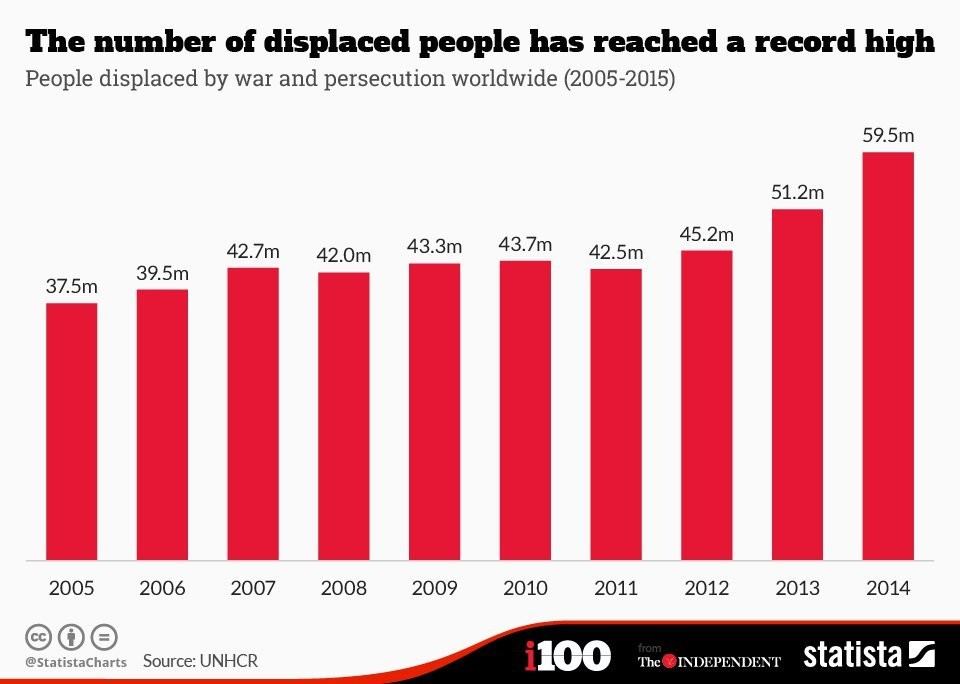
More than half of recent refugees come from three conflict-ridden countries – Syria, Afghanistan and Somalia – but significant numbers are also being forced to leave their homelands because of factors such as climate change and natural disasters.
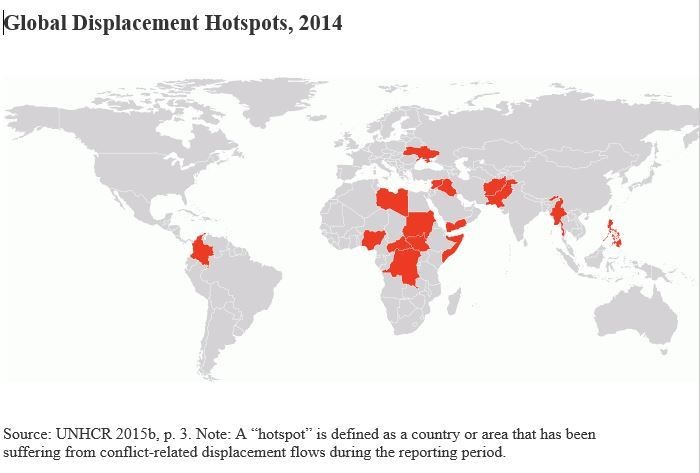
Involuntary migration is strongly interconnected with other risks that are considered of high concern in the longer term: not only interstate conflict and state collapse but also climate change and water crises.
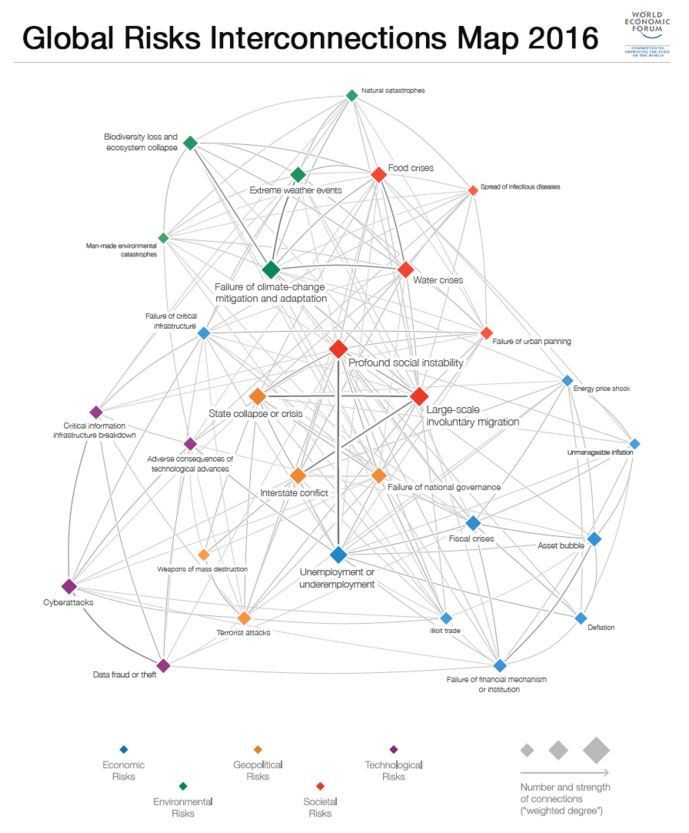
2. State collapse
Not surprisingly, as crises and conflicts spill over into 2016, the collapse of states is rated the second highest global concern in the next 18 months. Fragile or failing governments leave a space for armed groups to move in, and potentially export conflicts across borders, as ISIS have done in Iraq and Syria.

3. Interstate conflict
In third place is another geopolitical risk: interstate conflict. In 2016, the world is facing the prospect of more strategic competition between strong nations with conflicting interests on the one hand, and an increase in fragility and disintegration of states on the other. When these two trends merge, as they have done in Syria, Iraq and Yemen, for example, conflicts become more likely to take on regional and global dimensions.
4. Unemployment or underemployment
Unemployment, or underemployment, is rated the fourth highest concern in the next 18 months. Almost 30% of young people in the Middle East are unemployed, the highest rate of any region in the world. A lack of access to education and employment opportunities for people living in warzones and those displaced by war means they are likely to fall further behind, leading to more conflict.

5. Governance failure
Governance failure was named the fifth highest immediate concern. The breakdown of national governance is increasing in both societies affected by conflict and in countries facing economic crises and instability. The chart below shows the problem is pervasive across Latin America and sub-Saharan Africa and is among the top three most likely risks in the Middle East and North Africa, East Asia and the Pacific, and Central Asia. If countries fail to get a handle on their governance crises in 2016, it will become much harder to bring about peace and stability and ensure the rule of law.
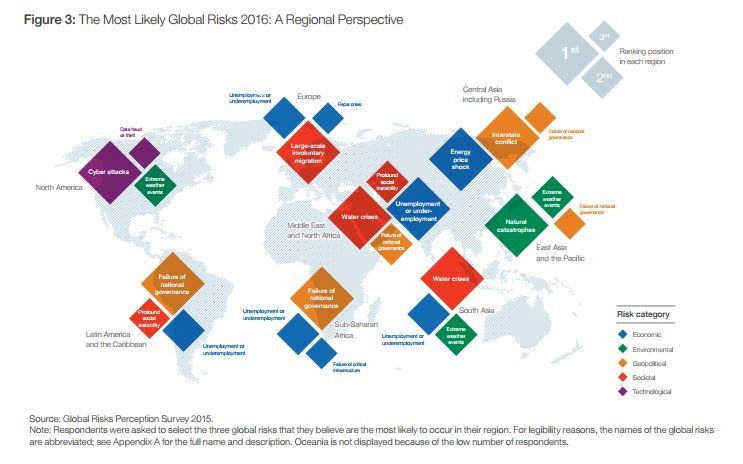
Don't miss any update on this topic
Create a free account and access your personalized content collection with our latest publications and analyses.
License and Republishing
World Economic Forum articles may be republished in accordance with the Creative Commons Attribution-NonCommercial-NoDerivatives 4.0 International Public License, and in accordance with our Terms of Use.
The views expressed in this article are those of the author alone and not the World Economic Forum.
Related topics:
Forum Stories newsletter
Bringing you weekly curated insights and analysis on the global issues that matter.
More on Global CooperationSee all
Zainab Azizi
April 9, 2025
Nii Simmonds and Obinna Isiadinso
April 9, 2025
Spencer Feingold
April 8, 2025
Fredy Vargas Lama
March 28, 2025
Neville Lai Yunshek
March 25, 2025
Niccolò Pisani
March 11, 2025





